Last Updated on
My Sheepadoodle’s first doggy friend was a Miniature Schnoodle named Moses.
Moses is a sweet pup, and eight years later, he and my Sheepadoodle are still best buds who love to romp and play together.
If you’re considering adding a Schnoodle to your family, you’re in the right place! Today, I’m diving into the sweet Schnoodle breed, so you know whether this dog is right for you.
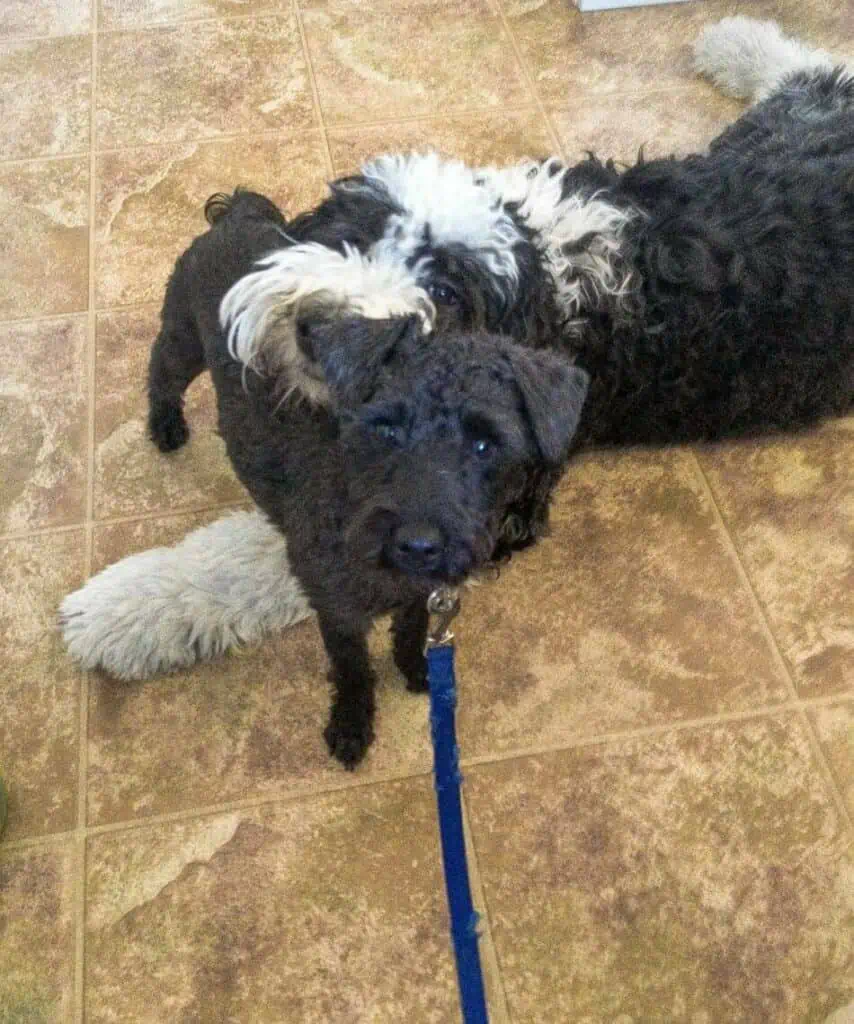
Ready? Let’s jump right in!
| Schnoodle dog breed facts | |
| Height | 10 to 12 inches |
| Weight | 10 to 20 pounds |
| Temperament | Affectionate, playful, intelligent, loyal, alert |
What is a Schnoodle?
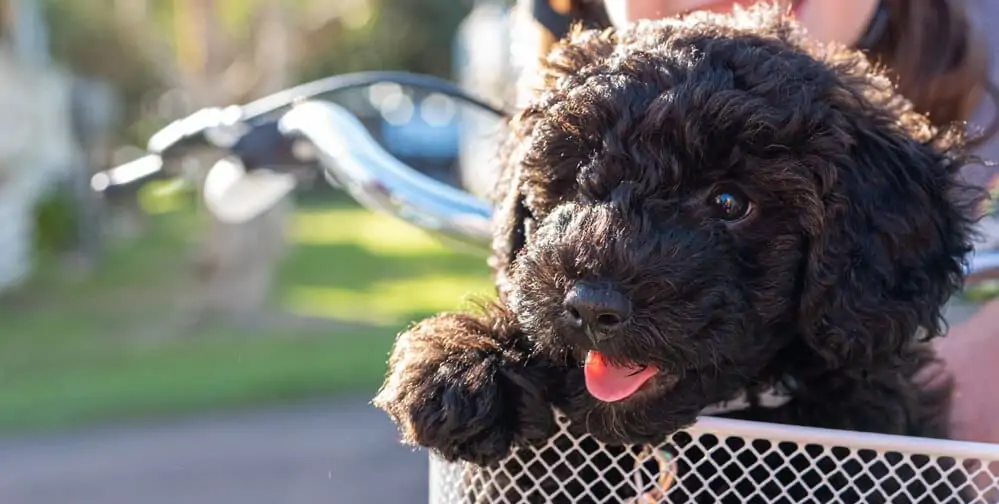
A Schnoodle is a mixed-breed dog, a cross between a Mini/Toy Poodle and a Schnauzer. Schnoodles are small low-shedding dogs ideal for families needing a low-shedding companion.
You can also get Giant Schnoodles—a cross between a Giant Schnauzer and a Standard Poodle, but in this article, we’ll be talking about the Miniature Schnoodle.
The Schnoodle is an excellent companion for families and can adjust to living with other dogs, children, and seniors.
Appearance
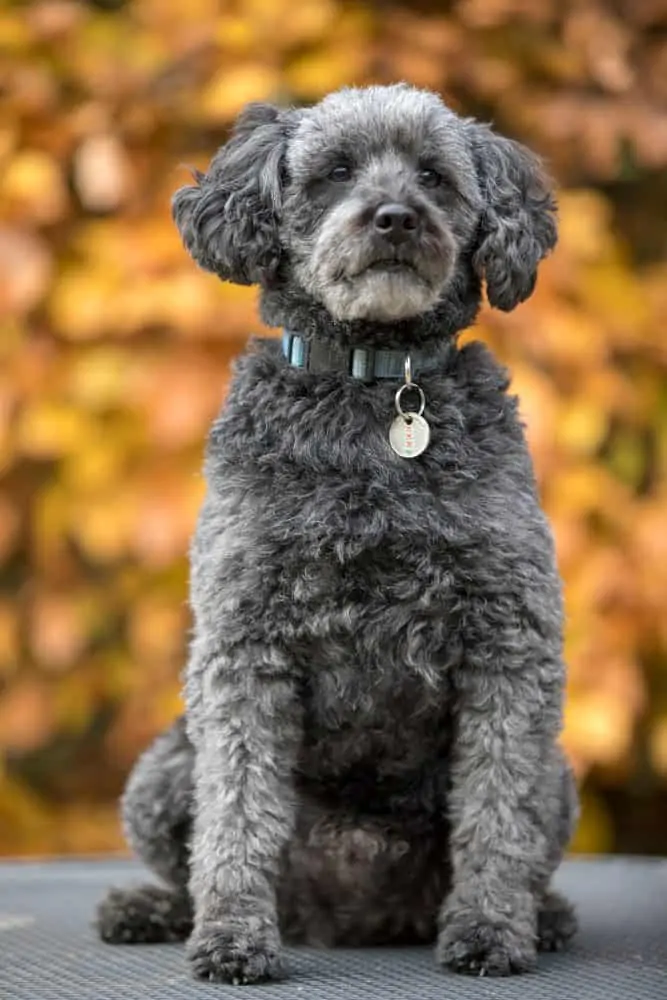
Like any other mixed-breed dog, when it comes to physical traits, a Schnoodle can have a wide variety of characteristics that largely depend on the traits of its parents.
However, one thing is certain: Schnoodles are incredibly sweet and adorable.
Let’s discuss some commonalities with the Schnoodle’s appearance.
Height and weight
These small dogs don’t get too big. Typically, Schnoodles stand 10 to 12 inches tall and weigh 10 to 20 pounds.
Coat texture
A Schnoodle’s coat textures depends on what kind of traits they inherit from the parent breeds, but broadly speaking, these pups’ coats range from wiry to straight to curly.
Most commonly, the Schnoodle puppy has a curly or wavy coat that is kept a medium length.
Colors
The American Kennel Club recognized three main colors for Schnauzers: salt and pepper, black and silver, and solid black. Mini/Toy Poodles, on the other hand, come in a broad range of colors like black, white, silver, blue, gray, cream, apricot, red, and brown.
Additionally, Poodles and Schnauzers can have different coat patterns like parti and tuxedo.
Being that there are so many different options for coat colors and patterns, you can expect a Schnoodle to be a range of colors!
The most popular color for Schnoodles is solid grey and solid black.
Grooming
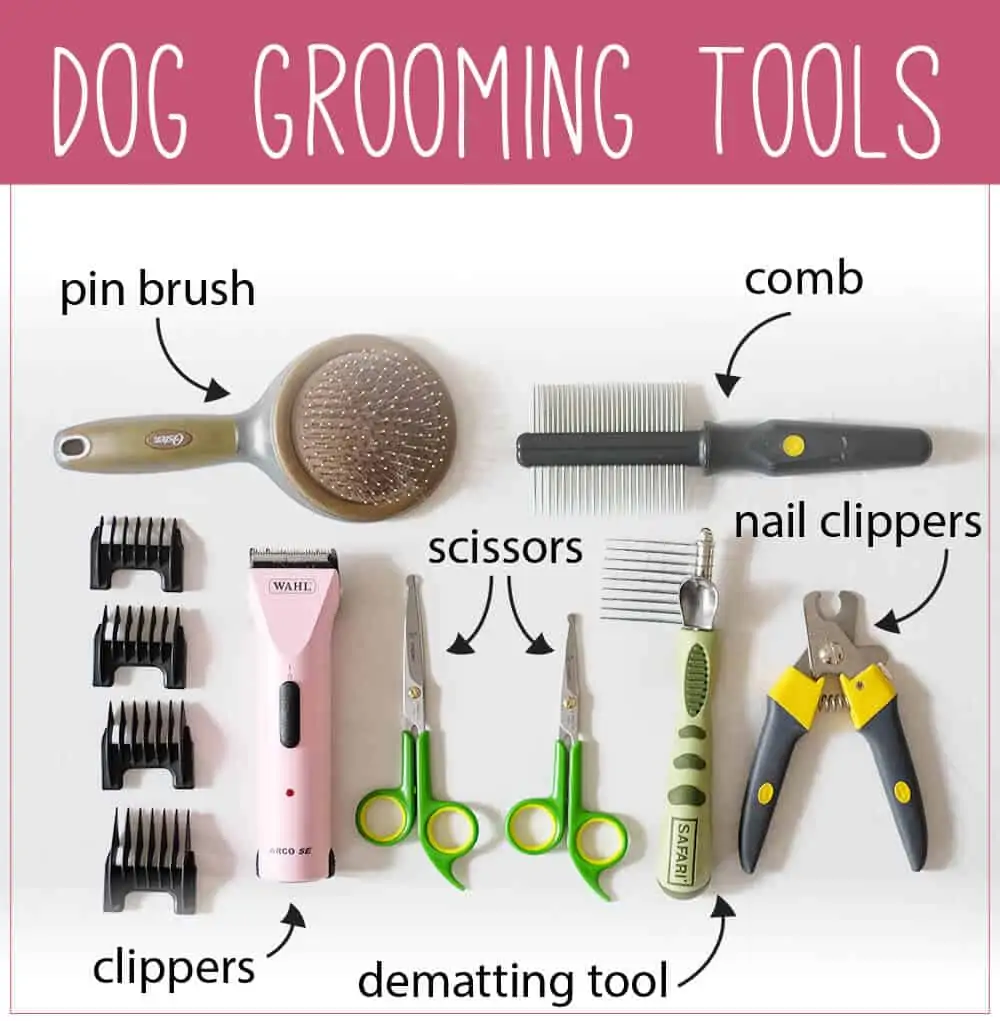
Having a non-shedding dog may seem like an easier option, but that is not always the case.
Miniature Schnoodles, for example, have high-maintenance coats that require a lot of at-home grooming.
To keep their beautiful coat in good condition, you’ll need to take them to a groomer every six to eight weeks.
You’ll also want to give your Schnoodle’s coat some love with regular brushing and combing. Ideally, you should do it every day, but at least once a week to keep their coat free from tangles and painful mats.
Additionally, Schnoodles need regular nail trims and ear cleanings. And don’t forget about taking them to the dentist for regular teeth cleanings, too. Since smaller dogs like Schnoodles can have crowded mouths, it’s important to make sure they get their teeth cleaned more frequently.
Personality and temperament
Before we dive into the charming personality of the Schnoodle, let’s take a look at its parent breeds to understand where this delightful temperament comes from.
Toy Poodle
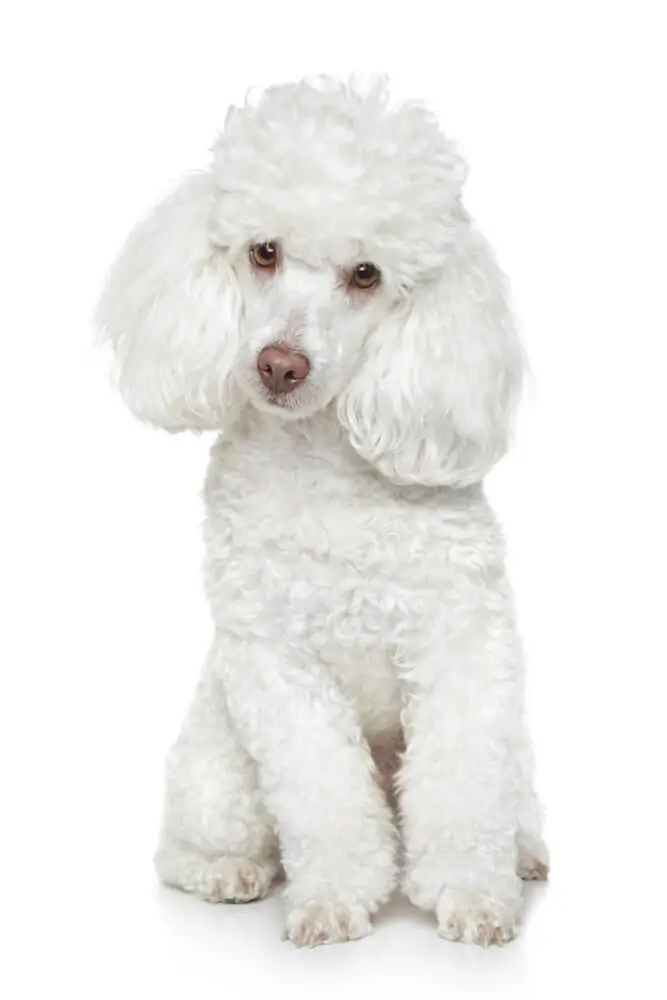
Back in the day, people bred Toy Poodles to be mushroom hunting dogs. Eventually, people learned how affectionate this little dog was and they began to breed them as companion dogs.
Today, people all over the world enjoy having the intelligent Toy Poodle in their family.
They are keen to learn new fun tricks and please their owners with their skills, but they must be trained in an environment with plenty of positive reinforcement.
Along with learning tricks, Toy Poodles have a lot of energy and love to play with their owners, families, and other dogs.
Miniature Schnauzer
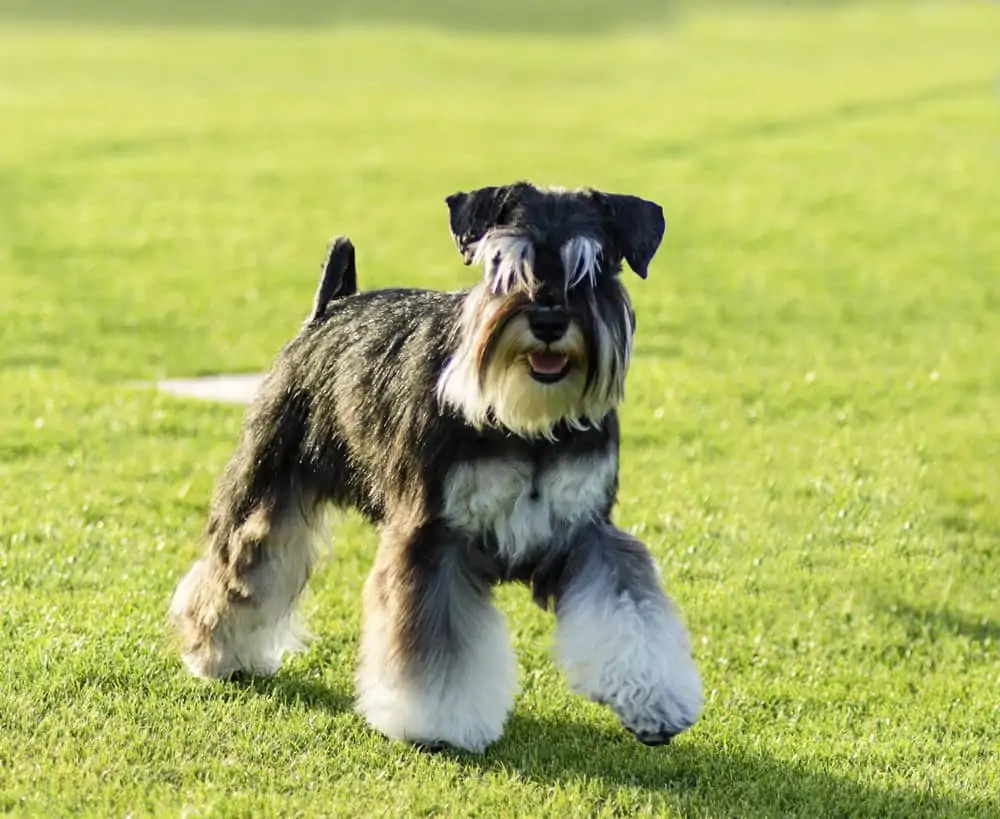
Now let’s talk about the other lovely half of the Schnoodle, the iconic Miniature Schnauzer.
Just like the Miniature Poodle, the Schnauzer is full of confidence, independence, and intelligence. They are ready to please you by learning tricks and obeying commands, and the Miniature Schnauzer will always be there to watch out and protect its loved ones.
The Schnauzer breed was originally bred as a ratter dog—a dog who kills small mice and vermin.
Being that the Miniature Schnauzer has such a high prey-drive, they aren’t recommended for families that have small animals like cats as they might try to chase other pets.
Schnoodle
Schnoodles are the perfect mix of both parent dogs! Let’s dive into each trait of this unique dog breed.
Affectionate
The Schnoodle is a very affectionate and loving companion. While the exact temperament depends on the dog, generally Schnoodles are cuddly and love to be near their owners.
Energetic and playful
The Schnoodle’s high energy level makes them excellent playmates for active families and people with children.
The Schnoodle loves to play and will keep everyone in the family in tip-top shape. Whether it’s playing fetch in the backyard or going for a run in the park, Schnoodles are always ready to play and have a good time with everyone.
Intelligent
Schnoodles are intelligent dogs that are easy to train and love to learn new tricks. Being so intelligent, they make excellent dogs for first-time dog owners.
Loyal
The Schnoodle dog is fiercely loyal. They love being around their families and like both parent breeds, have a protective nature.
Alert
The Schnoodle’s loyalty and protectiveness make them excellent watchdogs. They’ll bark and sound the alarm when strangers are nearing.
However, Schnoodles are not aggressive and don’t make good guard dogs.
Exercise needs
While Schnoodles aren’t always bouncing off the walls, they do require a moderate amount of physical and mental exercise. They love participating in dog sports such as agility, barn hunting, and obedience.
It’s recommended that Schnoodles get at least 30 to 60 minutes of exercise every day to keep them healthy and happy.
Being so intelligent, Schnoodles also need mental enrichment. To keep a Schnoodle mentally enriched you can turn to nose work, treat puzzles, and daily training.
Cost
Schnoodle puppies can range from $500 to $2,000. The exact price depends on the breeder and where you live.
Reputable breeders who take the time to health test their breeding dogs and raise their puppies in a loving and social environment may charge more for their puppies.
On the other hand, breeders who do not put as much effort into their breeding program may charge less.
If you see a Schnoodle for a price that seems too good to be true, it probably is. It’s never worth buying a puppy from a puppy mill or a backyard breeder, so please make sure to do your research when looking for a Schnoodle puppy.
Where to buy a Schnoodle
There are two places to find a Schnoodle:
1. Rescues
There are plenty of Poodle mix dogs in animal shelters across the country waiting for a loving home.
Before seeking out a breeder, consider searching through rescues. I put together a list of Poodle rescue agencies—use these as a starting point to see if there are any Schnoodle dogs up for adoption.
You can also search through Schnauzer-specific rescues, which often have Schnauzer mixes available to adopt. Here are a few to get you started:
- New Jersey Schnauzer Rescue Network
- MapleCreek Miniature Schnauzer Rescue (For Washington, Oregon, and Idaho areas)
- Schnauzer Love Rescue (For Alabama, Flordia, Mississippi, Georgia, Tennessee, South Carolina, and North Carolina areas)
- Schnauzer Rescue of the Mid-Atlantic ( For Virginia, Maryland, Delaware, Pennsylvania, and Washington, D.C. areas)
- Sheree’s Dog Rescue (In Texas but allows outside state adoptions)
2. Reputable breeders
If you can’t find a Schnoodle puppy to adopt, a reputable breeder is your next step. As mentioned earlier, you’ll want to ensure you aren’t purchasing from puppy mills.
Reputable breeders will answer any questions, potentially let you visit the puppies before choosing one, and vet you as a potential buyer.
They also provide health testing certificates and vet checkups, so you know your Schnoodle comes from healthy purebred dogs.
Health problems
A few health issues can be related to the Schnoodle breed, but this does not mean they are automatically born with them.
Typically, a breeder will health test the parent dogs to ensure no diseases get passed onto the pups.
However, diseases and illnesses can still happen over time, regardless of the health of the parent breeds.
Here are a few health conditions that Schnoodles may be prone to:
- Progressive Retinal Atrophy: This disease is when the cells in a dog’s eye deteriorate over time and eventually lead to blindness.
- Addison’s Disease: Addison’s Disease occurs when a dog’s adrenal gland is not producing enough cortisol and aldosterone hormones.
- Legg-Calve-Perthes Disease: This disease is the product of a spontaneous degeneration of the ball hip joint in the dog’s leg that can eventuall lead to arthritis.
- Dental issues: Small breeds are prone to dental issues. Yearly trips to the vet for teeth cleanings can prevent teeth from decaying and needing removal.
- Skin allergies: Schnoodles can develop skin allergies that can cause itching, redness, and inflammation. Brushing and frequent grooming can keep a Schnoodle’s skin and coat in good shape.
- Luxating patella: This condition causes a dog’s kneecap to dislocate from its normal position and can cause lameness and discomfort.
You can prevent many health issues by scheduling regular appointments with your vet, feeding your dog high-quality dog food, and providing them with the right amount of exercise.
Lifespan
Generally, Schnoodles can live anywhere from 12 to 15 years, which is typical for small to medium-sized breeds.
But you can make sure your Schnoodle lives a long and happy life by making sure they get plenty of exercise, regular check-ups at the vet, and lots of love.
Of course, every dog is different, so some may live shorter or longer than others.
Why the Schnoodle might not be the dog for you
Of course, no one would deny that the Schnoodle is a sweet and cute dog, but the Schnoodle may not fit everyone’s lifestyle, and that’s understandable!
Here are a few key points to review to see if this breed is the right one for you, or if perhaps there’s another one out there that may fit a bit better.
- The Schnoodle can be quite clingy, needing to be by your side and the center of attention almost always. If you are the only one in your household and are gone frequently, this may cause a dilemma. Lots of love and attention is required for these little guys!
- If you don’t want to have a dog with a high-maintenance coat that needs plenty of brushing and combing every day, this may not be the best fit for you.
- These little guys can also be prone to separation anxiety and can’t be left alone for long periods of time. If you work long hours and are away from home often, a Schnoodle might not be right for you.
- The Schnoodle is a medium to high-energy dog. If you’re looking for a dog to lay around with all day, the Schoodle is not a good option, and you might want to search for low-energy dogs instead.
After considering these important factors and getting to know the charming and loving Schnoodle, it’s up to you and your family to decide if this furry friend is the perfect addition to your household.
Adopting a Schnoodle can bring joy and create unforgettable memories with your loved ones!
Should you get a Schnoodle?
Miniature Schnoodles are adorable, affectionate, and intelligent dogs that make wonderful companions for families with children, individuals, and households with other dogs.
They inherit the best traits from their parent breeds, the Miniature Schnauzer and the Poodle, which makes them highly adaptable to different lifestyles and environments.
As with any dog, proper care, exercise, and regular vet check-ups are crucial to ensuring their health and happiness.
While they may require extra grooming and exercise, the joy and companionship that a Miniature Schnoodle can bring to your life make it all worthwhile.
If you’re looking for a loving and loyal furry friend, the Miniature Schnoodle may be the perfect choice for you.
Do you have a Schnoodle? Let us know in the comments below what they’re like!
FAQs
Yes, most Schnoodles are small dogs, although you can get Giant Schnoodles. Giant Schnoodles have a Giant Schnauzer and a Standard Poodle for parents.
Schnoodles do not shed very much—if any—dog hair.
No. The AKC does not recognize mixed breeds like the Schnoodle.
This article may include affiliate links. www.travellingwithadog.com is a participant of Amazon.com Services LLC Associates Program. As an Amazon Associate, I earn a commission from qualifying purchase. www.travellingwithadog.com participates in other affiliate programs, and recieves commissions when purchases are made through the links. The cost is not inflated to account for the commission earned.
Veterinary Disclaimer: travellingwithadog.com is not a substitute for veterinary advice and does not intend to provide any type of veterinary advice for your animals. Please consult your vet for any questions you have regarding your pets health.

About the Author:
Dana owns a Sheepadoodle and a rescue merle Labradoodle. Her first dog growing up was a white Toy Poodle and she’s loved dogs ever since. She has years of experience fostering dogs and has helped find homes for a variety of different breeds, both large and small! After seeing so many dogs end up unwanted and in shelters, she began blogging about different dog breeds (specifically Doodle dogs, since that’s what she knows best) to help people make informed choices when adding a new member to their family.
When Dana’s not brushing her Doodles’ hair (it takes a lot of time for two!) you can find her playing nose work games and fetch with her two amazing pups.
Learn more about her here.

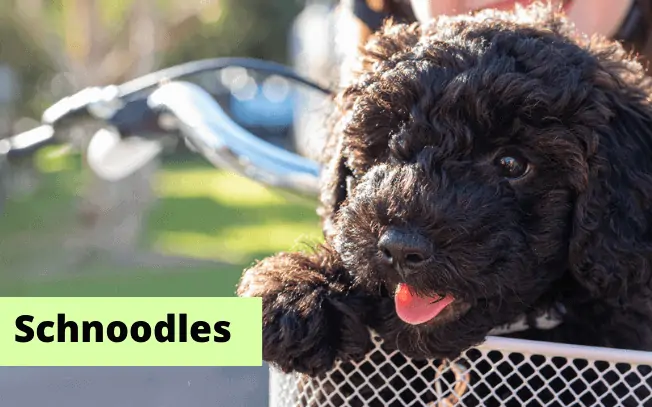
Just found this *Excellent*article on two great dogs; and non-biased info for both the Poodle and the Schnauzer—thus making the Schnoodle!❤️